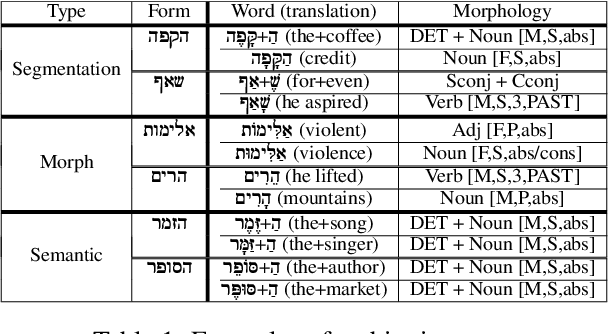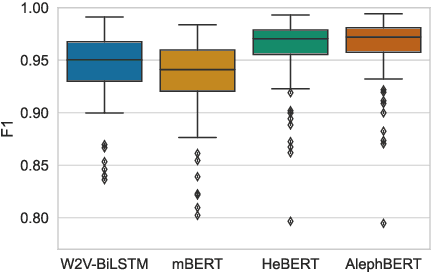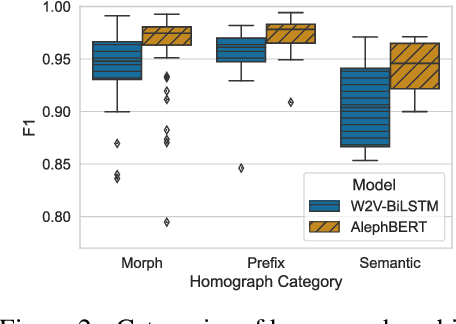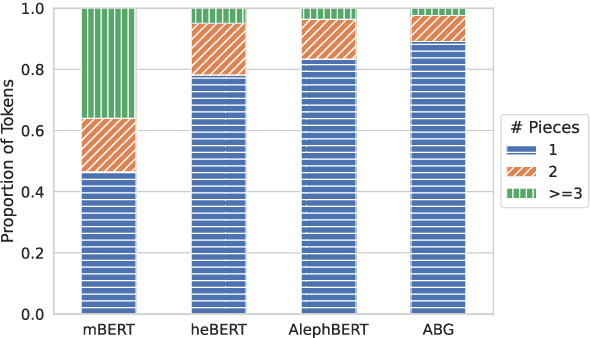Cheyn Shmuel Shmidman
Do Pretrained Contextual Language Models Distinguish between Hebrew Homograph Analyses?
May 11, 2024



Abstract:Semitic morphologically-rich languages (MRLs) are characterized by extreme word ambiguity. Because most vowels are omitted in standard texts, many of the words are homographs with multiple possible analyses, each with a different pronunciation and different morphosyntactic properties. This ambiguity goes beyond word-sense disambiguation (WSD), and may include token segmentation into multiple word units. Previous research on MRLs claimed that standardly trained pre-trained language models (PLMs) based on word-pieces may not sufficiently capture the internal structure of such tokens in order to distinguish between these analyses. Taking Hebrew as a case study, we investigate the extent to which Hebrew homographs can be disambiguated and analyzed using PLMs. We evaluate all existing models for contextualized Hebrew embeddings on a novel Hebrew homograph challenge sets that we deliver. Our empirical results demonstrate that contemporary Hebrew contextualized embeddings outperform non-contextualized embeddings; and that they are most effective for disambiguating segmentation and morphosyntactic features, less so regarding pure word-sense disambiguation. We show that these embeddings are more effective when the number of word-piece splits is limited, and they are more effective for 2-way and 3-way ambiguities than for 4-way ambiguity. We show that the embeddings are equally effective for homographs of both balanced and skewed distributions, whether calculated as masked or unmasked tokens. Finally, we show that these embeddings are as effective for homograph disambiguation with extensive supervised training as with a few-shot setup.
Large Pre-Trained Models with Extra-Large Vocabularies: A Contrastive Analysis of Hebrew BERT Models and a New One to Outperform Them All
Nov 28, 2022



Abstract:We present a new pre-trained language model (PLM) for modern Hebrew, termed AlephBERTGimmel, which employs a much larger vocabulary (128K items) than standard Hebrew PLMs before. We perform a contrastive analysis of this model against all previous Hebrew PLMs (mBERT, heBERT, AlephBERT) and assess the effects of larger vocabularies on task performance. Our experiments show that larger vocabularies lead to fewer splits, and that reducing splits is better for model performance, across different tasks. All in all this new model achieves new SOTA on all available Hebrew benchmarks, including Morphological Segmentation, POS Tagging, Full Morphological Analysis, NER, and Sentiment Analysis. Subsequently we advocate for PLMs that are larger not only in terms of number of layers or training data, but also in terms of their vocabulary. We release the new model publicly for unrestricted use.
Introducing BEREL: BERT Embeddings for Rabbinic-Encoded Language
Aug 03, 2022Abstract:We present a new pre-trained language model (PLM) for Rabbinic Hebrew, termed Berel (BERT Embeddings for Rabbinic-Encoded Language). Whilst other PLMs exist for processing Hebrew texts (e.g., HeBERT, AlephBert), they are all trained on modern Hebrew texts, which diverges substantially from Rabbinic Hebrew in terms of its lexicographical, morphological, syntactic and orthographic norms. We demonstrate the superiority of Berel on Rabbinic texts via a challenge set of Hebrew homographs. We release the new model and homograph challenge set for unrestricted use.
 Add to Chrome
Add to Chrome Add to Firefox
Add to Firefox Add to Edge
Add to Edge